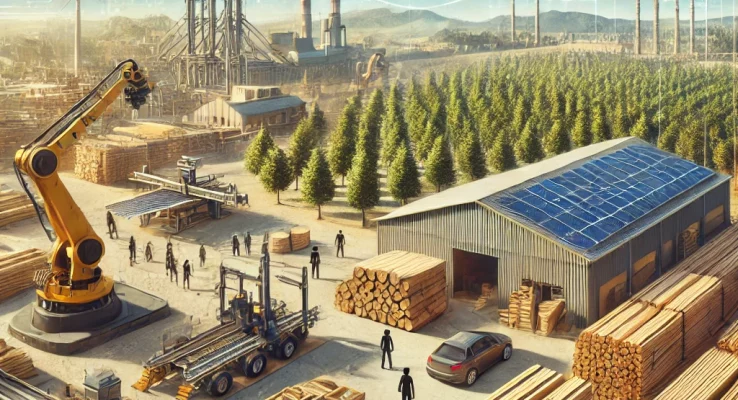


The U.S. lumber industry has long been a cornerstone of the nation’s construction sector, playing a vital role in residential, commercial, and infrastructure development. However, in recent years, the industry has faced a series of complex challenges and disruptions, ranging from environmental concerns to global trade dynamics. As we look to the future, the U.S. lumber industry is poised for significant transformation, driven by evolving market demands, sustainability initiatives, and technological innovations. Let’s explore the key trends, challenges, and opportunities shaping the future of the lumber industry.
1. Sustainability and Environmental Responsibility
One of the most prominent trends shaping the future of the lumber industry is the increasing emphasis on sustainability and environmental responsibility. Consumers, governments, and businesses are prioritizing eco-friendly building materials and practices, and the lumber industry is no exception. Forest management practices are evolving to promote sustainability, with more focus on reforestation, reducing deforestation, and maintaining biodiversity.
Additionally, the rise of green building certifications, such as LEED (Leadership in Energy and Environmental Design), has spurred demand for lumber sourced from sustainably managed forests. The adoption of certified wood products is becoming a competitive advantage for lumber suppliers as more construction projects prioritize environmental credentials.
Opportunity: Lumber producers can invest in sustainable forestry practices and certifications, such as those offered by the Forest Stewardship Council (FSC), to meet growing demand for eco-conscious materials.
2. Technological Advancements and Automation
The future of the U.S. lumber industry will be heavily influenced by advancements in technology and automation. The implementation of smart technologies in sawmills and lumber production facilities is already transforming the way lumber is processed, increasing efficiency and reducing waste. Automated cutting systems, laser scanning, and AI-driven optimization tools are enhancing productivity and allowing for more precise manufacturing.
Moreover, digital platforms are revolutionizing supply chain management, enabling lumber companies to better predict demand, manage inventory, and streamline distribution. These technologies are essential for maintaining competitiveness in an industry where margins can be tight and delays costly.
Opportunity: Lumber companies that embrace digitalization and automation will see significant gains in efficiency and the ability to scale production, improving their bottom line in a competitive market.
3. Evolving Housing and Construction Demand
The U.S. housing market continues to be a major driver of lumber demand, and its future trajectory will have a profound impact on the industry. With a growing population and an increasing demand for affordable housing, there is significant pressure on the construction sector to meet these needs.
However, factors such as rising interest rates, supply chain disruptions, and a shortage of skilled labor have impacted housing starts and the construction industry’s ability to keep up with demand. The cost of building materials, including lumber, has fluctuated wildly in recent years due to global supply chain challenges and trade restrictions.
Looking forward, the demand for multi-family housing, affordable homes, and renovations could fuel sustained demand for lumber. Additionally, the growing trend of mass timber construction, where entire buildings are constructed from engineered wood products, is likely to increase the demand for specialized lumber.
Opportunity: Lumber suppliers can capitalize on the demand for engineered wood products like cross-laminated timber (CLT), which is increasingly being used in sustainable and large-scale construction projects.
4. Supply Chain Volatility and Global Trade
The lumber industry is closely tied to global trade, and the U.S. has historically relied on imports from Canada to meet domestic demand. However, trade tensions, tariffs, and supply chain disruptions have led to fluctuating lumber prices and availability. The COVID-19 pandemic further exacerbated supply chain issues, driving up prices and creating shortages across the industry.
Looking ahead, the industry will need to adapt to global supply chain volatility by diversifying sources of lumber, investing in domestic production, and developing strategies to mitigate trade risks. As trade policies shift and international relations evolve, lumber companies must remain flexible and prepared for market fluctuations.
Challenge: Navigating the complexities of global trade and supply chain disruptions will require lumber companies to implement strategies that minimize risks and optimize sourcing.
5. Labor Shortages and Workforce Development
The U.S. lumber industry, like many sectors, is facing a significant labor shortage. An aging workforce combined with a lack of new talent entering the industry has created challenges for companies seeking skilled workers in lumber production, forestry management, and related fields. The difficulty in recruiting and retaining workers is compounded by the physically demanding nature of many lumber jobs.
In the future, the industry will need to invest in workforce development initiatives, including training programs, apprenticeships, and partnerships with educational institutions. Automation and technology can help alleviate some labor pressures, but human expertise will remain essential for many aspects of lumber production and forest management.
Opportunity: By focusing on workforce development and training, lumber companies can build a skilled, sustainable labor force that can adapt to the evolving needs of the industry.
6. Climate Change and Forest Health
Climate change presents both a challenge and an opportunity for the U.S. lumber industry. Increasingly volatile weather patterns, wildfires, and pest infestations threaten the health of forests across the country, potentially reducing the availability of high-quality timber. At the same time, the role of forests in carbon sequestration and climate mitigation is gaining recognition, positioning the lumber industry as part of the solution to global climate challenges.
Sustainable forestry practices that promote forest health and resilience will be critical for the future. Managing forests in a way that balances production with conservation will allow the industry to thrive while also playing a vital role in combating climate change.
Adapting to a Changing Landscape
The future of the U.S. lumber industry is one of transformation and opportunity. While the industry faces challenges such as supply chain volatility, labor shortages, and the impacts of climate change, it also has the potential to thrive through sustainability initiatives, technological advancements, and innovative product development.
By embracing these changes and investing in the future, the U.S. lumber industry can continue to play a critical role in building the nation’s homes, infrastructure, and communities, while contributing to a more sustainable and resilient world.